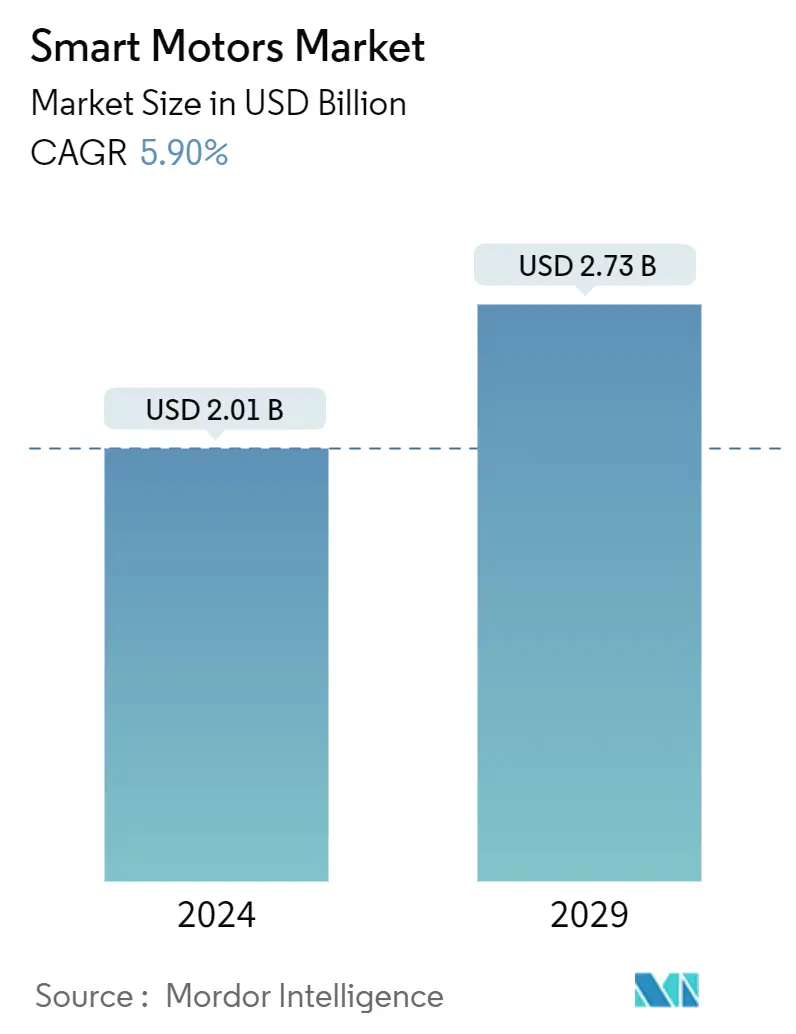Market Size of Smart Motors Industry

| Study Period | 2019 - 2029 |
| Market Size (2024) | USD 2.01 Billion |
| Market Size (2029) | USD 2.73 Billion |
| CAGR (2024 - 2029) | 5.90 % |
| Fastest Growing Market | Asia Pacific |
| Largest Market | Asia Pacific |
Major Players
*Disclaimer: Major Players sorted in no particular order |
Smart Motors Market Analysis
The Smart Motors Market size is estimated at USD 2.01 billion in 2024, and is expected to reach USD 2.73 billion by 2029, growing at a CAGR of 5.90% during the forecast period (2024-2029).
The term' smart factory' refers to various fully integrated automation solutions adopted for manufacturing facilities. Such integration helps streamline the material flow during all the processes involved in manufacturing, allowing the movement of materials across the factory floor effectively.
- Several manufacturing companies are qualified to achieve zero waste production and shorter time-to-market. Effortless monitoring, waste reduction, and production speed are significant advantages of automated manufacturing processes. This technology offers users improved standardization quality and dependable products within the time and at a much lower cost.
- Advancements in electronics and data analytics recently led to the introduction of smart devices with built-in intelligence. Their integration with communication technologies and the Internet enables the Internet of Things (IoT). According to Cisco, 8.7 billion handheld or personal mobile-ready devices and 4.4 billion M2M connections will be available by 2023.
- Mobile M2M connections enabled a broad range of IoT applications and represented 34% of global mobile devices and connections in 2023. Tremendous shifts in manufacturing due to Industry 4.0 and the approval of IoT require enterprises to adopt agile, more brilliant motors to advance production with technologies that complement and augment human labor with automation and reduce industrial accidents caused by process failure.
- For instance, one of the critical advantages of smart electric motors is their ability to provide valuable insights into motor performance and efficiency. Operators can monitor its condition by collecting and analyzing data from sensors integrated into the motor in real-time.
- This allows for proactive maintenance, as potential issues can be recognized and addressed before they lead to costly breakdowns. Additionally, the data collected can be used to optimize motor performance, leading to energy savings and improved overall efficiency.
- Many organizations still lack information about measures that reduce energy usage, installation of energy-efficient solutions, information on numerous energy-efficiency opportunities, and the technologies for enhancing the performance of the utilized energy because some of the greatest barriers to enterprise adoption of IoT are the complexity and access to talent that understands this complexity holistically. This challenges the market's growth, resulting in a low implementation rate of smart motors.
Smart Motors Industry Segmentation
The study tracks the revenue accrued through the sale of the smart motor market by various players in the global market. The study also tracks the key market parameters, underlying growth influencers, and major vendors operating in the industry, which support the market estimations and growth rates over the forecast period. The study further analyses the overall impact of COVID-19 aftereffects and other macroeconomic factors on the market. The report’s scope encompasses market sizing and forecasts for the various market segments.
The smart motors market is segmented by component (variable speed drive, motor), by application (industrial, commercial, automotive, aerospace and defense, oil and gas, metal and mining, water and wastewater, and other applications), by geography (North America, Europe, Asia Pacific, Latin America, and Middle East and Africa). The report offers market forecasts and size in value (USD) for all the above segments.
| By Component | |
| Variable Speed Drive | |
| Motor |
| By Application | |
| Industrial | |
| Commercial | |
| Automotive | |
| Aerospace and Defense | |
| Oil and Gas | |
| Metal and Mining | |
| Water and Wastewater | |
| Other Applications |
| By Geography | |
| North America | |
| Europe | |
| Asia | |
| Australia and New Zealand | |
| Latin America |
Smart Motors Market Size Summary
The smart motors market is poised for significant growth, driven by the increasing adoption of automation and IoT technologies across various industrial sectors. Smart motors, integrated with advanced control features and data analytics, are becoming essential in enhancing production efficiency, reducing energy consumption, and minimizing maintenance costs. These motors are particularly valuable in smart manufacturing, industrial automation, and robotics, where they facilitate precise control and real-time monitoring of machinery. The transition towards Industry 4.0 and the need for energy-efficient solutions are further propelling the demand for smart motors, as industries strive to optimize operations and reduce reliance on manual labor.
Regionally, Asia-Pacific stands out as a key market for smart motors, with countries like China and India leading the charge due to their focus on industrial automation and renewable energy. Initiatives such as 'Make in India' and 'Made in China 2025' are fostering the growth of smart motor technology by promoting manufacturing hubs and encouraging the adoption of energy-efficient solutions. The market is characterized by a high degree of fragmentation, with major players like Siemens AG, Schneider Electric SE, and Turntide Technologies Inc. actively engaging in strategic partnerships and acquisitions to enhance their product offerings. These developments, coupled with substantial investments in sectors like oil and gas, are expected to sustain the market's growth trajectory in the coming years.
Smart Motors Market Size - Table of Contents
-
1. MARKET INSIGHTS
-
1.1 Market Overview
-
1.2 Industry Attractiveness - Porter's Five Forces Analysis
-
1.2.1 Bargaining Power of Suppliers
-
1.2.2 Bargaining Power of Buyers
-
1.2.3 Threat of New Entrants
-
1.2.4 Threat of Substitutes
-
1.2.5 Degree of Competition
-
-
1.3 Industry Value Chain Analysis
-
1.4 Impact of COVID-19 Aftereffects and Other Macroeconomic Factors on the Market
-
-
2. MARKET SEGMENTATION
-
2.1 By Component
-
2.1.1 Variable Speed Drive
-
2.1.2 Motor
-
-
2.2 By Application
-
2.2.1 Industrial
-
2.2.2 Commercial
-
2.2.3 Automotive
-
2.2.4 Aerospace and Defense
-
2.2.5 Oil and Gas
-
2.2.6 Metal and Mining
-
2.2.7 Water and Wastewater
-
2.2.8 Other Applications
-
-
2.3 By Geography
-
2.3.1 North America
-
2.3.2 Europe
-
2.3.3 Asia
-
2.3.4 Australia and New Zealand
-
2.3.5 Latin America
-
-
Smart Motors Market Size FAQs
How big is the Smart Motors Market?
The Smart Motors Market size is expected to reach USD 2.01 billion in 2024 and grow at a CAGR of 5.90% to reach USD 2.73 billion by 2029.
What is the current Smart Motors Market size?
In 2024, the Smart Motors Market size is expected to reach USD 2.01 billion.

